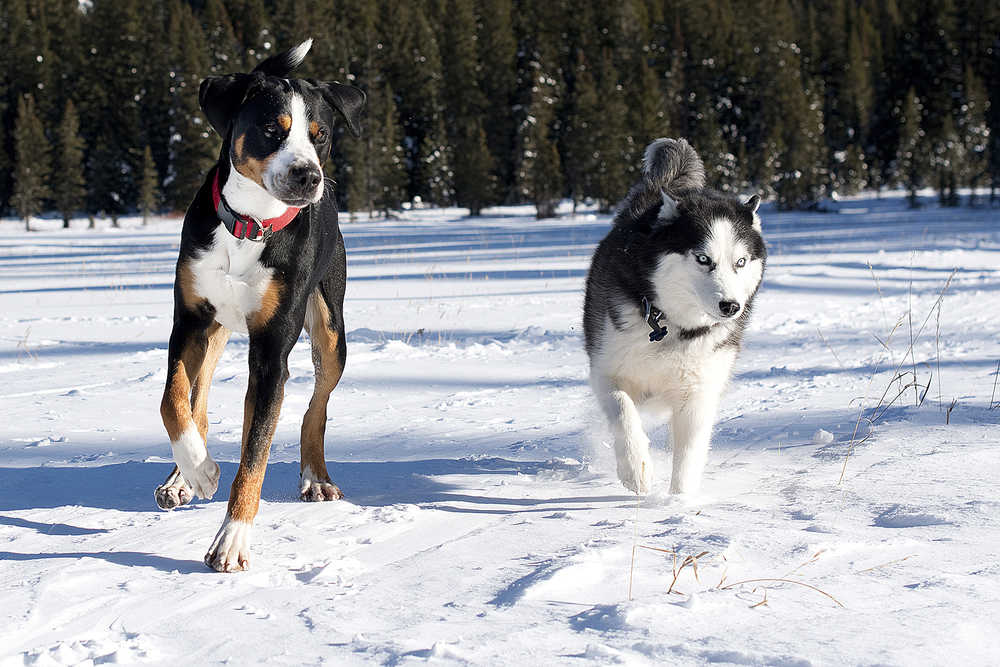BOZEMAN, Mont. — On a recent cross-country ski trip in the Bridger Mountains, I noticed my dog was walking a little funny. It was a frigid day and close to a foot of snow had fallen the night before. Kato, who burst out of his kennel with his usual exuberance at the car park, was looking chilly on the trail.
At first, Kato — a 9-year-old mixed breed cattle dog — was pausing to chew the snowballs out from between his pads. I’d seen him do this plenty of times in the past and thought little of it, but then he began to sit down, and finally he started to seek out spots beneath the trees that weren’t snow covered.
While Kato has always been a trooper, I grew concerned.
“If it is below zero, you might want to really think about being outside with your dog,” said Dr. Spencer Anderson of Baxter Creek Veterinary Clinic in Bozeman. “It is very dog dependent, and a lot of it has to do with acclimation, but you need to know your dog.”
Anderson said he rarely sees cases of hypothermia in dogs. Many breeds, such as Labrador Retrievers, Siberian Huskies, Chesapeake Bay Retrievers and Alaskan Malamutes, are built for the cold. Even in shorthaired dogs like Hungarian Vizslas and German Shorthaired Pointers, which generally have low body fat in addition to a fine coat, hypothermia is uncommon.
If you see your dog shivering and they can’t stop, it is a clear sign that their core body temperature has dropped. Dogs that are too cold may curl up into a ball or repeatedly look for areas to bed down. Anderson said if you think your dog is too cold, give them food and keep them moving.
“They will be warmer and better able to generate heat when they are moving,” Anderson said. “If they can’t move, get them out of the wind or to a place you can build a fire and get them warm and dry. It’s just like treating a person with hypothermia.”
Anderson said more common winter maladies for our canine companions come in the form of frozen extremities, lacerations and orthopedic injuries.
Exposed or poorly insulated tissue around the eyes, ears, nose and tail can become frozen when exposed to extreme cold. The pads of the feet are also susceptible. Anderson said keep an eye in the snow for spots of blood, which could indicate frostbite.
Josh Allen, owner of Dee-O-Gee in Bozeman, said booties made for dogs offer a degree of protection during cold weather outings. Booties can be as simple as latex balloons that fit over your pup’s paws, or highly specialized footwear with Vibram soles, aggressive tread and fabric gaiters.
“I wouldn’t know looking at a dog walking in here if they would tolerate a bootie,” Allen said, “but if it is introduced correctly and sized properly, dogs will generally wear them.”
To prevent the ice chunks from forming between the pads of your dog’s feet, Allen recommends a product called Musher’s Secret. Developed by sled dog racers, the salve coats the hair between the pads and prevents snow and ice from building up.
Dog vests are another popular product for pets that like to recreate in the cold. Made from neoprene, wool or other fabrics, the vests function just a like a coat, insulating the torso.
One of the most common ailments Anderson treats is lacerations. Whether the result of a cut from a shard of ice or being run over by a ski, cuts are a common winter injury for dogs. Anderson said to bandage the wound in the field if possible before transporting your pet back to town.
Orthopedic issues can also plague dogs during the winter months. As dogs age they may develop arthritis, which can be exasperated by cold temperatures. Dogs suffering from arthritic pain may appear stiff or uncomfortable while walking.
Anderson said ACL and back injures often strike dogs during the winter. Post holing through the snow or slipping on ice frequently result in injury.
“You get those dogs porpoising like crazy through deep snow and they may develop a sore back,” Anderson said. “If you can run them on packed snow, that is a good idea.”
For people who leave their pets outside during the day, Anderson said the American Veterinary Medical Association (www.avma.org) and the American Society for the Prevention of Cruelty to Animals (www.aspca.org) publish guidelines on safe shelter for dogs during the winter months.
“A lot of it is common sense,” Anderson said. “If you have a dog that just flat won’t quit, you have to be careful. You have to know your dog.”

